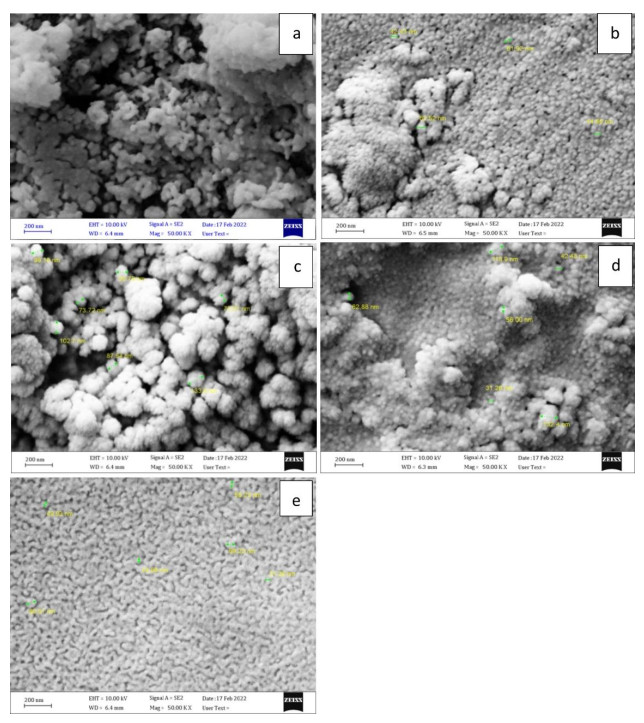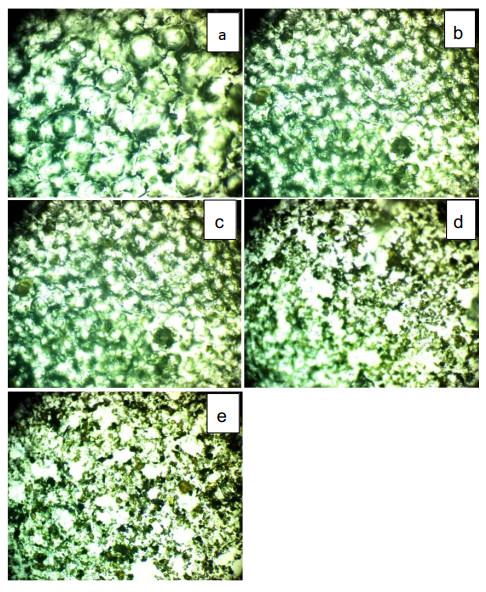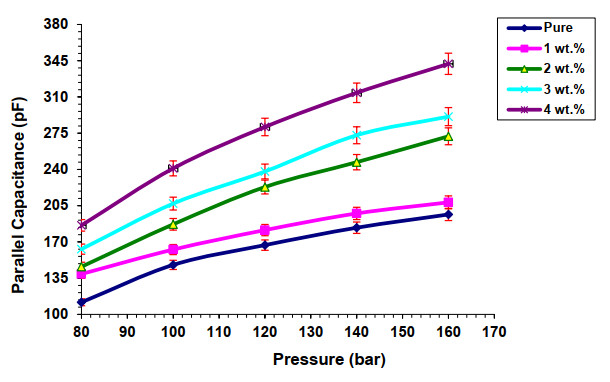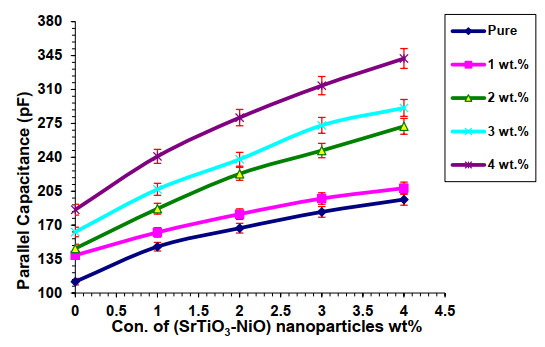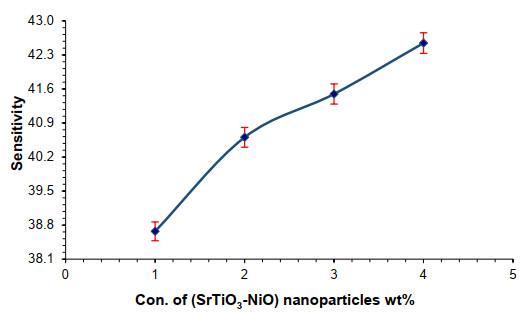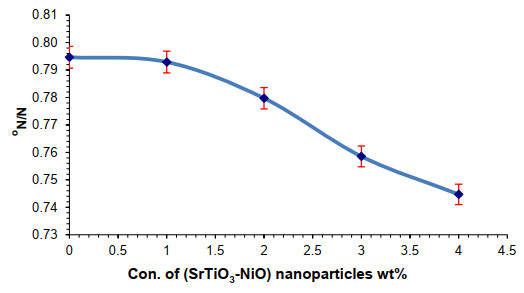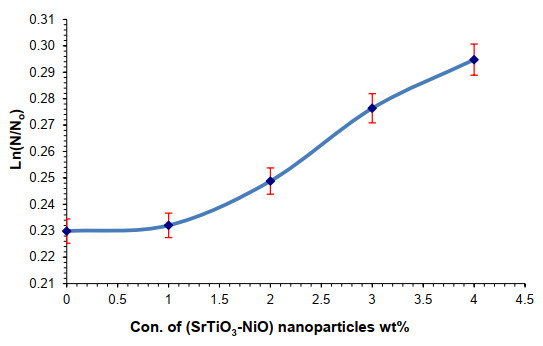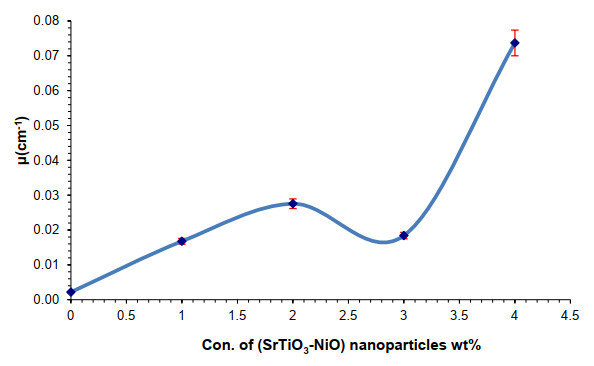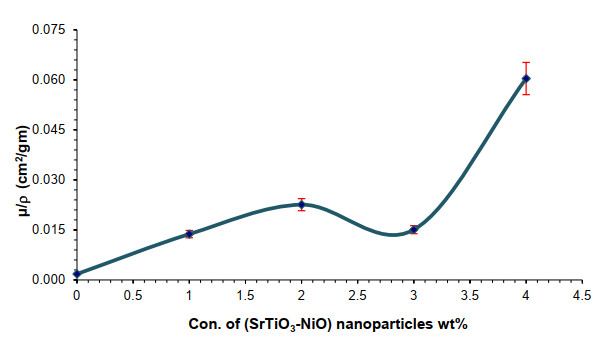1.
Introduction
The manufacturing of novel polymer nanocomposites has been extensively researched in recent years in the sectors of barrier fields, coatings, antibacterial, sensors, antiballistic goods, conductive and other materials. The sort of the additive the polymer matrix uses has an impact on nanoparticles. The applications include a wide range of industries, such as electronics, aircraft, the military, transportation and medical [1,2]. With only one polymer, it is impossible to personalize the final result of the blending process to fit the needs of the applications. Polyethylene oxide is a semi-crystalline and linear polymer (PEO). Given that polyethylene oxide is a linear polymer, a high degree of crystallinity is permitted by the regularity of the structural device. The cations of the metal salts can interact and connect with the polar group O in the chemical structure of PEO [3]. Numerous salt varieties can be resolved with PEO. However, because of the C–O, C–H and C–C bonds in its structural unit, it is chemically and electrochemically stable, and has a low level of reactivity. The high concentration of the crystalline phase, however, limits the conductivity of the polyethylene Oxide polymer [4]. One of the first, and most popular polymers, is polyvinyl alcohol (PVA), which is utilized extensively in semiconductor manufacturing today [5]. It has been shown that SrTiO3 possesses persistent photoconductivity, which indicates that shining light on the crystal causes it to become more electrically conductive by one factor or more. In the last forty years, a variety of semiconductors, including SrTiO3 NPs, with adequate conduction band locations and band gaps, were employed as photo catalysts to split water for the production of hydrogen [6]. Due to their high thermal and chemical stability, environmental friendliness and industrial use, nickel oxide nanoparticles NiO NPs, one of the most significant transition metal oxides, have a variety of properties when reacting with polar surface materials. When radiation particles fall on matter, the energy of these particles is gradually transmitted to matter through collisions with atoms of matter until they stop. As a result of these collisions, the atoms of the substance are ionized; that is, the electron is completely separated from its atom. The way gamma ray energy is lost varies in matter, photoelectric effect, pair production and the Compton effect. A gamma photon interacts with one of the electrons in the inner levels of the atom; with electrons in the last orbit of the atom. In this interaction, the beam is dispersed. The fallen one's direction changes, and its energy decreases [7]. Х-rays and γ-rays have many applications in military, medical, health, scientific and agricultural industries. Increasing the utilization of hazardous radiations, including gamma sources in hospitals and research centers for diagnostic and therapeutic applications, has provided a more insecure place for personnel. Thus, there will be a need to design an appropriate shield [8]. Other applications of polymer nanocomposites are flexible electronics, solar cells, anti-static devices, electromagnetic interference shields, radiation shields, nuclear materials in reactors, battery electrode materials, lightweight energy storage devices, super-capacitors, piezoelectric sensors, radiation sensors, lightweight spacecraft electronics and ionizing radiation dosimeters [9,10,11]. Shielding of radiation is especially a crucial section in the programs of radiation protection. Typically, concrete is the general and normally used matter to the radiation shielding in mainly facilities, like hospitals. The huge available quantity and cost efficiency of concrete were its major advantages as a shielding material. However, it has several disadvantages, like the cracks that may happen after a long period of time of exposure to radiation and the difficulty of transporting it. The synthetic polymers can be employed to manufacture novel materials, and may be used to make a radiation shielding. Furthermore, their additional advantages, like durability, low industrialized cost and high chemical and thermal stability, are amid the preferential traits and quality used for greater shielding [12]. Different researchers have studied pressure sensors and gamma shielding. Shirinov et al. [13] studied a piezoelectric polyvinyl lidene fluoride (PVDF) film. The properties of the sensor have been experimentally investigated. The cross-sensitivity to temperature and humidity, and the response time were measured. They found that the capacitance of film increased as pressure increased. Janczak et al. [14] studied the characteristics of PMMA/PVDF/Gr nanocomposites. They showed that the relationship between resistance and pressure is nearly linear on a logarithmic scale for selected types of samples, and their response is several times higher than for similar sensors with graphite layers. Gavrish et al. [15] found an improvement in thermo physical, radiation-shielding and mechanical properties by varying the amount of tungsten nanopowder. Bi2O3was dispersed in Bi2O3/XNBR films, in the concentration range of 30–70 wt% by Liao et al. [16], where these samples had an effective role in attenuating low energy gamma rays. Abdalsalam et al. [17] showed that; samples were fabricated by adding 0.5, 1, 1.5, and 2 wt% of Bi2O3 into ultra-high molecular weight polyethylene, and then using a hot-press. The results of this study indicated that the measurements of (μ/ρ) for energies between 30.8 and 383.9 keV showed that the specimen with 2 wt% Bi2O3 exhibited the highest photon attenuation. This work aims to prepare and characterize PEO/PVA/SrTiO3/NiO nanocomposites for pressure sensors and gamma ray attenuation.
2.
Materials and methods
In this work, nanocomposites were created by combining (PEO/PVA) in 40 mL distilled water with a magnetic stirrer at 70 ℃ for 45 min to produce a more uniform solution. The addition of (SrTiO3/NiO) NP with concentrations 0, 1, 2, 3, and 4 wt% followed the casting method (Figure 1). The samples were tested at different concentrations by using an Olympus type Nikon-73346 optical microscope, which has a magnifying power of (10×) and is equipped with a camera used in the microscopic photography. A scanning electron microscope was used for the surface morphology of (PEO/PVA) and (SrTiO3/NiO) NCs. Dual Broker Flash EDS detectors and Broker flash HD EBSD (Czech Tuscan Instrument Co.) were included in the Tuscan Mira3 SEM microscope for analytical issues. Using nanocomposites for gamma ray shielding, the gamma-ray attenuation characteristics for volume fractions changing concentrations of (SrTiO3/NiO) nanoparticles have been studied. Samples were positioned in front of a collimated beam coming from gamma ray sources (Cs-137.5 mci). The distance between the gamma ray and the detector was two centimeters. The linear attenuation coefficients were calculated using Geiger counter measurements of transmitted gamma ray fluxes via nanocomposites made of PEO/PVA/SrTiO3/NiO NCs. The usefulness of the pressure sensor NCs was assessed by calculating the parallel capacitance between the two poles above and below the specimen using the LCR matrix for various pressure ranges (80–160 bar).
The following Eq 1 may be used to get the linear attenuation coefficients (μ) from the thicknesses of the material [18,19]:
where No is a gamma ray incident, N is the attenuation of the gamma rays and x is the thickness of the sample.
3.
Results and discussion
3.1. Scanning electron microscope (SEM) measurements of PEO/PVA/ SrTiO3/NiO NCs
The whole impact of SrTiO3/NiO nanoparticle concentration is investigated, and the dispersion of nanocomposites particles in the polymer matrix is examined using a scanning electron microscope. Figure 2 depicts a SEM micrograph of pure blend surface for films made of PEO/PVA /SrTiO3/NiO NCs, which were applied one after the other with varying amounts of SrTiO3/NiO nanoparticles. For polymer blend, image (a) in Figure 2 is found to be transparent, correlated and has a consistent shape, which reveals a rather soft surface. The surface morphology of the polymer blends PEO/PVA SrTiO3/NiO in Figure 2a, c changes with increasing nanoparticle ratios. Nanocomposites films exhibit numerous spherical particle aggregates or chunks that are evenly dispersed, and widely spaced on the surface. This could be a sign of a homogeneous growth mechanism [20,21,22]. Surface morphology varies as the nanoparticle ratio in polymer blends rises, see Figure 2c. When the SrTiO3/NiO NCs rise, the grain clumps. The results would show the PEO/PVA/SrTiO3/NiO membranes' surface morphology. As the concentration of SrTiO3/NiO NCs increases, more aggregates or fragments are randomly distributed on the upper surface of nanoparticles [23,24].
3.2. Optical microscope for PEO/PVA/SrTiO3/NiO NCs
Figure 3 shows cross-sectional photomicrographs of PEO/PVA/SrTiO3/NiO nanocomposites at a power of 10× magnification. It was discovered that the SrTiO3/NiO nanoparticles and the PEO/PVA mixture could be readily distinguished in the nanocomposites. The SrTiO3/NiO nanoparticles exhibit an annularly linked network in the PEO/PVA matrix, which is caused by the filler's sponge-like form. This indicates that the nanoparticles fill the matrix in a regular three-dimensional manner. The PEO/PVA mixture completely filled the interspace of the SrTiO3/NiO nanoparticle sponges, and, based on the detailed photomicrographs in Figure 3, there is a clear distinction from the tests [25]. This is shown by the good contacts between the SrTiO3/NiO nanoparticle structure and blend matrix without any obvious cracks or pores. In nanocomposites, the shape can be distinguished clearly. Nanoparticles begin to link in a continuous network when SrTiO3/NiO NP concentration reaches 4 weight percent. A network of charge carriers can travel through the nanoparticles coupled to the PEO/PVA polymers in the films, changing the properties of the material [26,27,28].
3.3. Application of PEO/PVA/SrTiO3/NiO nanocomposites for piezoelectric sensors
Figure 4 depicts the parallel capacitance fluctuation for PEO/PVA/SrTiO3/NiO nanocomposites with the pressure for various SrTiO3/NiO nanoparticle concentrations. This figure shows that the capacitance of nanocomposites increases as pressure does [29,30]. The nanocomposite samples include an internal dipole moment. This is called a dipole moment. If there are no forces (electrical or mechanical), the net dipole is in a straight line, as momentum equals zero. As the strain gets bigger, these dipole moments will cause local distributions to change when they are applied to the samples, creating an electric field. Because of this electric field, there are charges above and below the sample [31,32,33].
The influence of SrTiO3/NiO nanoparticles on the electrical capacitance (Cp) for PEO/PVA/SrTiO3/NiO NCs is shown in Figure 5 at 80 bars. It is clear from this graph that the electrical capacitance of nanocomposites increases as the concentration of SrTiO3/NiO nanoparticles concentration increases. This might be related to an increase in charge carrier density in nanocomposites [34].
The influence of SrTiO3/NiO nanoparticles on sensitivity for PEO/PVA/SrTiO3/NiO NCs is shown in Figure 6. It is clear from this graph that the sensitivity of nanocomposites increases as the concentration of SrTiO3/NiO nanoparticles concentration increases. This is due to internal dipole moment [35,36].
3.4. Application of PEO/PVA/SrTiO3/NiO for gamma ray shielding
Fluctuation of (N/No) for a mixture of PEO/PVA with various quantities of SrTiO3/NiO nanoparticles is shown in Figure 7. When increasing concentration of SrTiO3/NiO nanoparticles, the transmission radiation decreases. This happens due to an increase in the attenuation radiation [37,38]. Figure 8 shows increasing Ln(N/No) of PEO/PVA mixture with increasing SrTiO3/NiO NPs concentrations.
Figure 9 shows attenuation coefficient for the PEO/PVA mixture, with varying numbers of SrTiO3/NiO nanoparticles. When the results of polymer nanocomposites and concrete in the figure below were compared, they looked very similar. However, the composite polymer was better than concrete because it was more mobile, had no electrical properties and could prevent neutrons from escaping [39]. The attenuation coefficients rise with increasing SrTiO3/NiO nanoparticles. This is because shielding materials are made of nanocomposites, which either absorb or reflect gamma rays [40,41,42].
Figure 10 shows the mass attenuation coefficient (µ/ρ) as a function of concentration of NPs. From this figure, mass attenuation coefficient increases by increasing the concentration of NPs. This is because shielding materials are made of nanocomposites, which either absorb or reflect gamma rays [43,44].
4.
Conclusions
In this study, polymer nanocomposites (NCPs), based on PEO/PVA mixture, were synthesized by means of a solution cast technique. SEM images revealed that the homogenous and coherent surface morphology of the PEO/PVA/SrTiO3/NiO NCs films, pieces or aggregates are dispersed randomly over the top surface. Images captured by an optical microscope revealed that SrTiO3/NiO NPs form a continuous network within the PEO/PVA mixture, and the distribution of SrTiO3/NiO NPs additives was homogeneous in the mixture. The results indicate that when pressure increases, the electrical capacitance of PEO/PVA/SrTiO3/NiO NCs increases. Finally, as the concentration of NPs increases, the attenuation coefficient rises. From these results, it can be concluded that these nanocomposites can be considered as excellent materials for manufacturing low cost, light weight, flexible piezoelectric sensors and gamma ray attenuation.
Acknowledgments
Acknowledgments to University of Babylon.
Conflict of interest
We declare no conflicts of interest.
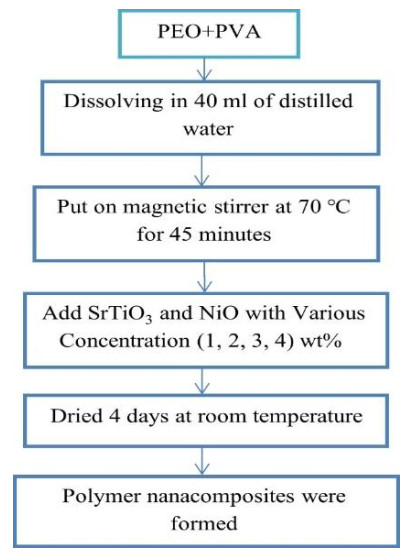









 DownLoad:
DownLoad:
